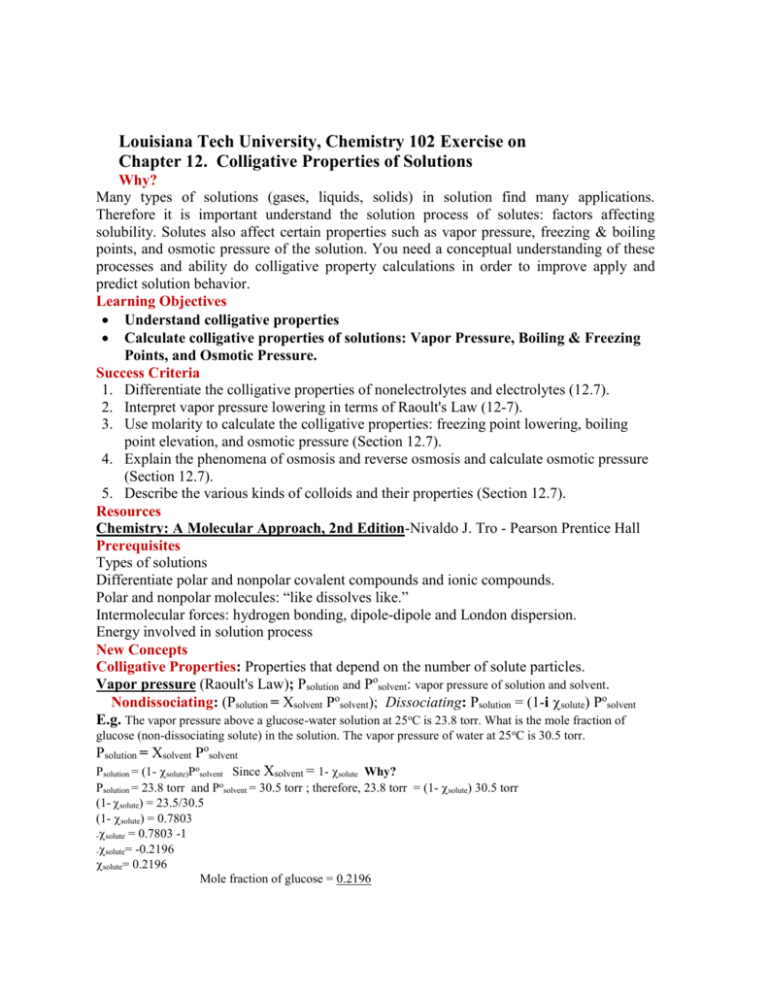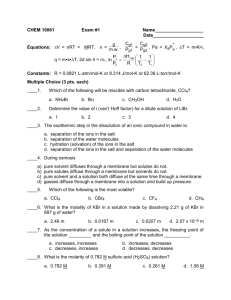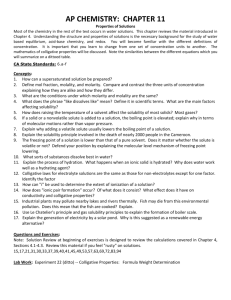
Louisiana Tech University, Chemistry 102 Exercise on
Chapter 12. Colligative Properties of Solutions
Why?
Many types of solutions (gases, liquids, solids) in solution find many applications.
Therefore it is important understand the solution process of solutes: factors affecting
solubility. Solutes also affect certain properties such as vapor pressure, freezing & boiling
points, and osmotic pressure of the solution. You need a conceptual understanding of these
processes and ability do colligative property calculations in order to improve apply and
predict solution behavior.
Learning Objectives
Understand colligative properties
Calculate colligative properties of solutions: Vapor Pressure, Boiling & Freezing
Points, and Osmotic Pressure.
Success Criteria
1. Differentiate the colligative properties of nonelectrolytes and electrolytes (12.7).
2. Interpret vapor pressure lowering in terms of Raoult's Law (12-7).
3. Use molarity to calculate the colligative properties: freezing point lowering, boiling
point elevation, and osmotic pressure (Section 12.7).
4. Explain the phenomena of osmosis and reverse osmosis and calculate osmotic pressure
(Section 12.7).
5. Describe the various kinds of colloids and their properties (Section 12.7).
Resources
Chemistry: A Molecular Approach, 2nd Edition-Nivaldo J. Tro - Pearson Prentice Hall
Prerequisites
Types of solutions
Differentiate polar and nonpolar covalent compounds and ionic compounds.
Polar and nonpolar molecules: “like dissolves like.”
Intermolecular forces: hydrogen bonding, dipole-dipole and London dispersion.
Energy involved in solution process
New Concepts
Colligative Properties: Properties that depend on the number of solute particles.
Vapor pressure (Raoult's Law); Psolution and Posolvent: vapor pressure of solution and solvent.
Nondissociating: (Psolution = solvent Posolvent); Dissociating: Psolution = (1-i solute) Posolvent
E.g. The vapor pressure above a glucose-water solution at 25oC is 23.8 torr. What is the mole fraction of
glucose (non-dissociating solute) in the solution. The vapor pressure of water at 25 oC is 30.5 torr.
Psolution = solvent Posolvent
Psolution = (1- solute)Posolvent Since solvent = 1- solute Why?
Psolution = 23.8 torr and Posolvent = 30.5 torr ; therefore, 23.8 torr = (1- solute) 30.5 torr
(1- solute) = 23.5/30.5
(1- solute) = 0.7803
-solute = 0.7803 -1
-solute= -0.2196
solute= 0.2196
Mole fraction of glucose = 0.2196
b) Boiling point elevation: Tb and Kb: boiling point change and boiling point constant of solvent.
Nondissociating: ( Tb = Kb msolute); Dissociating: (T = i Kb msolute)
c) Freezing point depression: Tf and Kf: freezing point change and f- point constant of solvent.
Nondissociating: ( Tf = Kf msolute); Dissociating: (T= i Kf msolute)
d) Osmotic pressure: Nondissociating: ( = MRT ); Dissociating: (
= i MRT)
Dissociating solutes: One that brakes up into ion during solution process.
(E.g. CaCl2 --- 1 Ca2+ + 2 Cl-). For . CaCl2, i, Vant Hoff Factor =3/1= 3.
Particles of ions in the solution
mol of a
Moles solute
i = Vant Hoff Factor =
Particles solute dissolved
mol of a + b ; msolute = Kg solvent
E.g. Calculate the osmotic pressure in torr of a 0.500 M solution of NaCl in water at 25oC. Assume a
100% dissociation of NaCl
= i MRT
= Osmatic pressure of the solution = ?
M= Molarity of the solute in the solution = 0.500 M
R = Ideal gas constant = 62.4 L-torr/mol K
T= Temperature of the solution in Kelvin = 25oC +273.15 = 298.15 K
i = (NaCl ---1 Na+ + 1Cl-), 1 + 1 = 2
= 2 x 0.500 M x 62.4 L-torr/mol K x 298.15 K
Chapter 12 GHW#2 Printed Name:__________________ Group Name:__________
Key Questions
1) What are colligative properties?
2) What’s Rauolts Law? How it applies to
a) a volatile & nondissociating,
b) nonvolatile & nondissociating,
c) nonvolatile & dissociating solutes in a solution of volatile solvent.
3) What is the vapor pressure (atm) of a solution of a nonvolatile, nondissociating solute(mole
fraction 0.25) in water at 50oC? The vapor pressure of water at 50oC is 0.122 atm.
4) What is the total pressure at 25oC of a solution of 2.90 moles of C6H14 and 5.94 moles of
C6H12 at 25oC if the vapor pressures of the pure solvents are 151 and 98 mm Hg respectively
at 25oC?
(Atomic weights: C = 12.01, H = 1.008, Cl = 35.45).
5) What is ideal, positive and negative behavior applying Raoult's Law.
a) Ideal:
b) Positive:
c) Negative:
Exercises
6) Which of the following solutes dissolved in 1000 g of water estimate the number particles in
the solution? Use Vant Hoff factor.
a) 0.030 moles urea, CO(NH2)2 (a covalent compound)
b) 0.030 moles acetic acid, CH3COOH(weak acid)
d) 0.030 moles ammonium nitrate, NH4NO3(soluble)
e) 0.030 moles calcium sulfate, CaSO4 (insoluble)
f) 0.030 moles aluminum chloride, AlCl3 (soluble)
7) Determine the molecular weight of acetic acid if a solution that contains 30.0 grams of acetic
acid per kilogram of water freezes at -0.93oC. Do these results agree with the assumption that
acetic acid has the formula CH3CO2H? Kf (water) = 1.86.
8) Explain why a 0.100 m solution of HCl dissolved in benzene has a freezing point depression
of 0.512oC, while an 0.100 m solution of HCl in water has a freezing point depression of
0.352oC. Kf (benzene) = 5.5, Kf (water) = 1.86.








